This is a continuation of a series of posts on the Nikon D850. You should be able to find all the posts about that camera in the Category List on the right sidebar, below the Articles widget. There’s a drop-down menu there that you can use to get to all the posts in this series; just look for “D850”.
Jack Hogan read yesterday’s post and asked what would happen if the AF Adjustment of the D850 were optimized for a narrower aperture. Here’s what happens when the 58/1.4 is optimized for f/1.4, f/1.8 and f/2.8:
The CoCs are so large that I had to double the scale of the vertical axis, and I still couldn’t get all the curves in. You can get good results from f/2.8 through f/8 by tuning for f/2.8, but apertures wider than f/2 suffer unacceptably. F/1.8 seems like a better compromise, but you could also argue that tuning for that aperture gives you unacceptable results much wider or much narrower.
The Sigma 50/1.4 Art, plotted at the same scale, has very little focus shift, and lower sigma to boot:
If we measure the Sigma 85/1.4 and the 135/1.8 at the same scale, here’s what it looks like:
Looks like the 85/1.4 might benefit from adjusting the AF Adjustment to optimize performance at f/2.
If we do that, here’s what happens:
To see better how that is working, let’s change the vertical axis back to plus and minus 20 um:
My take on the 85 here, if we don’t care about stops wider than f/2? Pretty good, but not great.
Clearly, AF tuning strategy on the D850 depends on knowing the focus shift characteristics of your lenses.
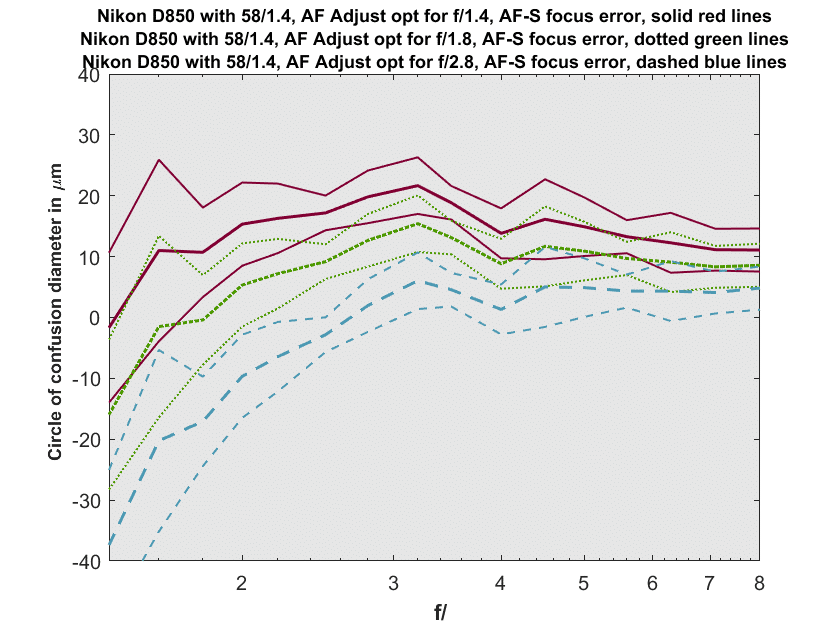
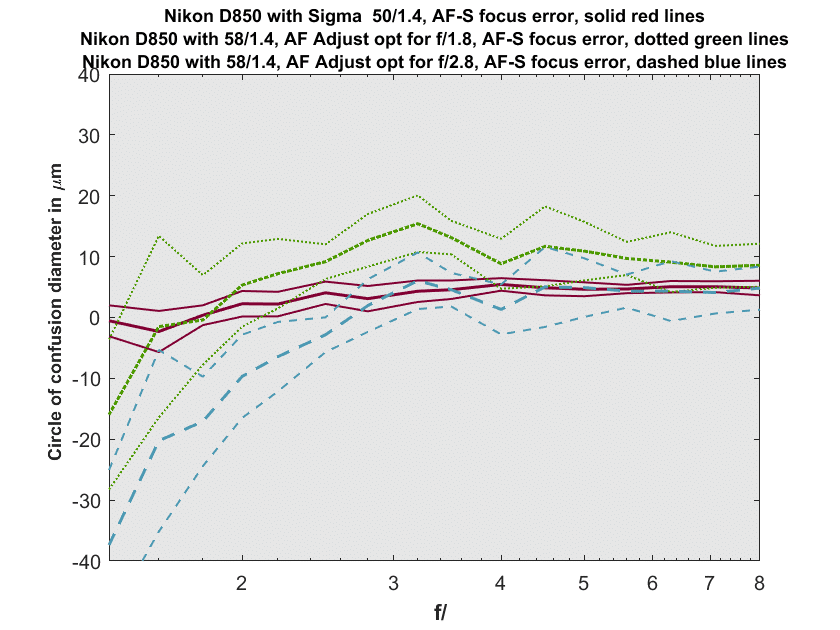
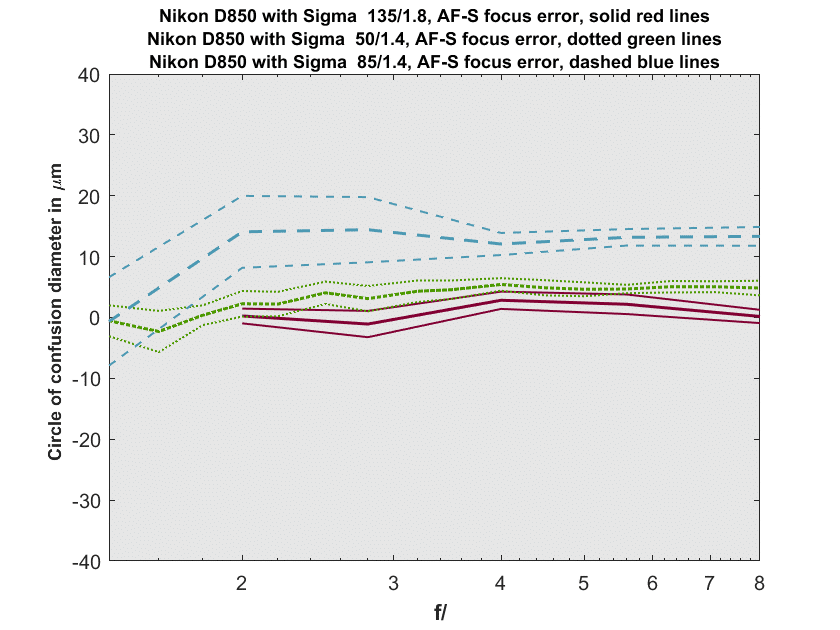
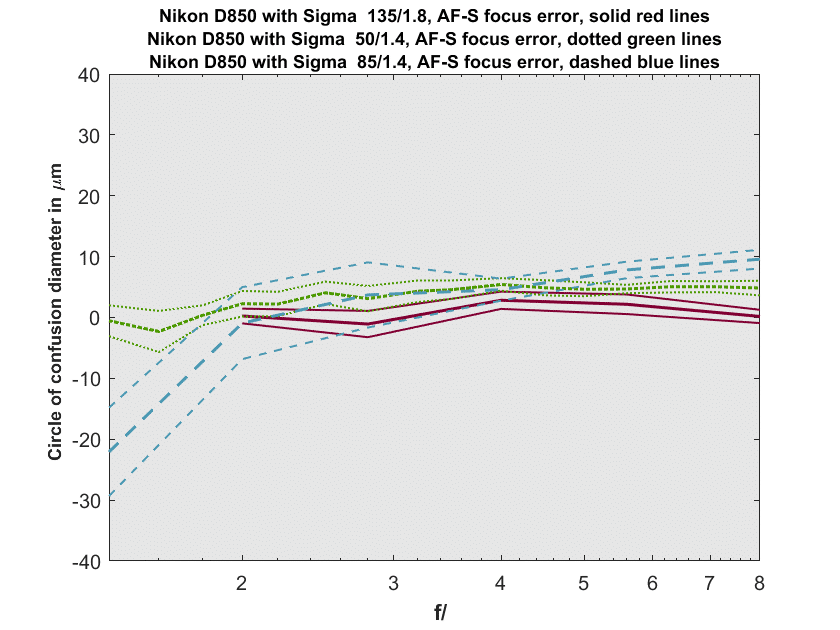
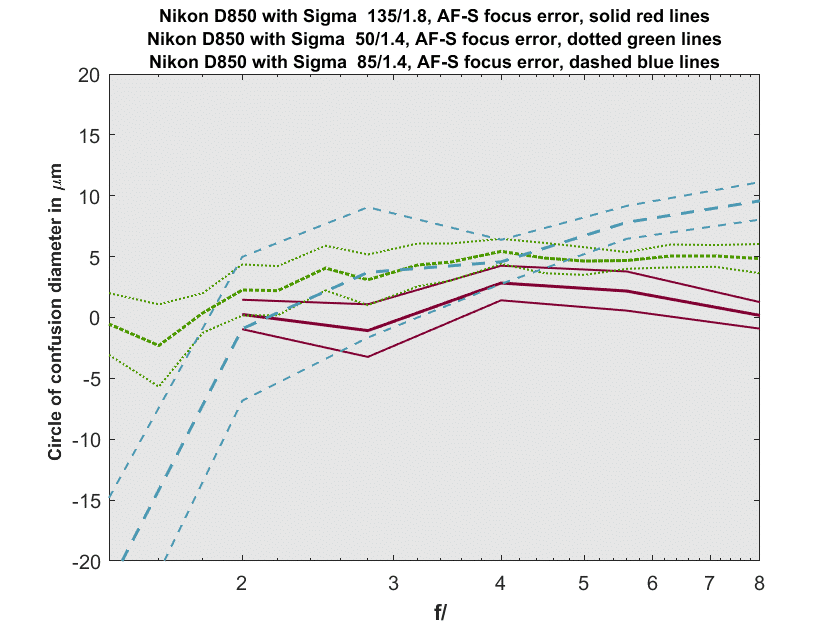
I see, thanks for indulging me Jim.
Jim,
Based on all of the work you’ve done I find myself reconsidering using a Sony again. Right now though I am in the same frame of mind when I had the Sony A7r and resisted the move to Nikon. It’s not the sunk cost because I’d do OK on that and it wouldn’t be painful to make the transition (less than a day’s wages all in). But I look again and again and ask, try to find see the difference in a Sony (A7rii or iii) image vs a Nikon (D810 or 850) and can’t see any advantage to Sony’s output.
I am looking through some overcast day images caught this AM with the D850 and 70-200 vrii lens and using f 2.8 and f4 at base ISO (bright enough) I find image after image of a moving toddler that excels any photos I’ve seen by others using Sony’s AF and eye AF.
This is what matters. There may be what appears to be huge differences in a lab setting but in the real world I know I can count on Nikon and that the inverse of what you see in a lab is true when it comes to what ends up on my post processing screen and examples of Sony images I’ve seen.
I will at least rent the A7riii and I have a stellar Zony55 to test it with and I’ll even run this head to head with a Sigma 50 on the Nikon. But I don’t think the IQ will be there with the examples I’ve seen today.
Maybe you could run a real world test the next time the kids visit?
If you’re happy with what you’re getting out of your D850, why mess with a good thing? I did a head-to-head a7RIII/D850 test at Christmas, and it confirmed to me what I had observed under completely uncontrolled circumstances. Of course, I didn’t use lenses with the same characteristics on the two cameras, since I use different lenses on the D850 than I do on the a7x/a9 cameras.
Because I am just like you and 10,000 others that buy Otus lenses and the D850 the day its released. Good enough with the D810 and Sigma and or Otus lenses isn’t the best.
If there is something better, outputting better IQ and works the way I use cameras (so far no MF seems ready for the way I shoot) then I want it and will use it.
I’ll look at your xmas photos again.
Arthur, how about a GFX 50S as a bridge to the GFX 100S? The lenses are incredible. The AF is fast enough for a lot of things, but not sports.
I think about it but I really like the idea of having 1 camera that does it all.
Maybe a rental soon to dip my toes in the water.
There’s a big difference between us. I’ve never found one camera that did it all, even going back to high school, where I had a Nikon S2 and a Speed Graphic.
Why wouldn’t it at least stop down to f/2.8 to focus? That would get rid of most focus shift issues I think. Maybe it shouldn’t do that in extremely low light however.
Thanks a lot Jim for this great post, your data gave me confidence on my own similar findings for Sigma 85mm Art!
I actually found this post of yours when I was trying to find data for Tamron 35mm 1.8 VC focus shift and possible Nikon focus shift compensation. Been having some issues with the Tamron focusing as well, but might just be distance variation. Tamron is now at the firmware update, after that I can dial distance specific afma to the lens with Tap-in console and do more stringent testing.
I had done expansive focus adjust with the Sigma dock at all distance F/1.4, but pictures taken at other apertures were not up to the par of the lenses great sharpness.
I decided to try focus tuning with slightly narrower apertures and to my surprise the focus tuning values ended up being 0/0/0/0 when I evaluated pictures thru F/1.4 to F/2.8. When adjusting at F/1.4 I had like +5/+6/+4/0. This got me thinking; is sigma also optimizing this lens at F/2? They must be aware of the focus shift characteristics and how big it is at below F/2.
Now the sigma 85mm is one my best focusing lenses. I might measure the needed camera afma value for pin-point F/1.4 sharpness for the times I need to shoot strictly F/1.4.
I posted some pictures of before and after to Dpreview forums, these images are 1.35m away to make the the difference easier to see. Focus shift at F/1.4 is smaller than I expected when using “offset af-tune”.
https://www.dpreview.com/forums/thread/4271969